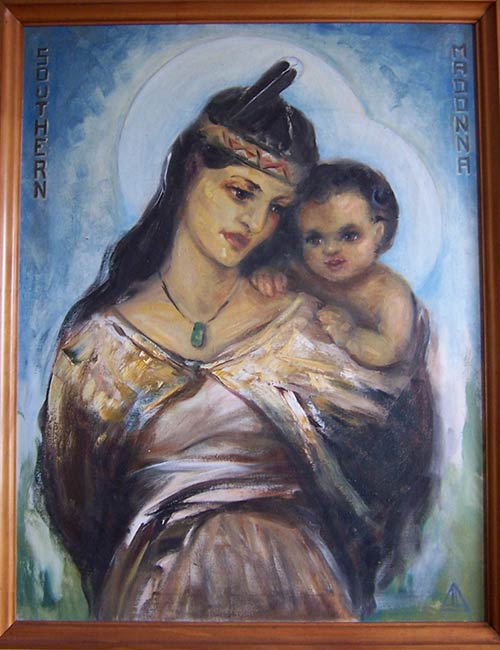
It hangs in the church at Southern Star Abbey, Kopua.
August 15 is the Feast of Mary, the mother of Jesus. The day has many titles: The Assumption, the Dormition, the Feast of the Blessed Virgin Mary… In some places the feast is regarded as so special that it is moved to Sunday (or, one might argue, it is not regarded as special enough, and there’s a fear that not enough will turn up to celebrate the feast on a week day…)
There are some resources here: The Blessed Virgin Mary, Mary mother of Jesus, and Mary Consoles Eve. And here is a reflection by Protestants in a Coptic Orthodox context as they reflected on the place of Mary as the community prepared for this feast.
What resources, thoughts, reflections can you add to enrich the lives of those who gather around this site? Please add them in the comments.
Mary: Grace and Hope in Christ is the 5th statement of the second phase of the Anglican-Roman Catholic International Commission (ARCIC). Here are some quotes from this in relation to today’s feast day:
The dogmas of the Immaculate Conception and the Assumption raise a special problem for those Anglicans who do not consider that the precise definitions given by these dogmas are sufficiently supported by Scripture. For many Anglicans the teaching authority of the bishop of Rome, independent of a council, is not recommended by the fact that through it these Marian doctrines were proclaimed as dogmas binding on all the faithful. Anglicans would also ask whether, in any future union between our two Churches, they would be required to subscribe to such dogmatic statements…
Anglicans and Roman Catholics agree that the doctrines of the Assumption and the Immaculate Conception of Mary must be understood in the light of the more central truth of her identity as Theotókos, which itself depends on faith in the Incarnation. We recognize that, following the Second Vatican Council and the teaching of recent Popes, the Christological and ecclesiological context for the Church’s doctrine concerning Mary is being re-received within the Roman Catholic Church. We now suggest that the adoption of an eschatological perspective may deepen our shared understanding of the place of Mary in the economy of grace, and the tradition of the Church concerning Mary which both our communions receive. Our hope is that the Roman Catholic Church and the Anglican Communion will recognize a common faith in the agreement concerning Mary which we here offer. Such a re-reception would mean the Marian teaching and devotion within our respective communities, including differences of emphasis, would be seen to be authentic expressions of Christian belief….
We affirm together… that the teaching about Mary in the two definitions of the Assumption and the Immaculate Conception, understood within the biblical pattern of the economy of hope and grace, can be said to be consonant with the teaching of the Scriptures and the ancient common traditions …
More positively, ‘assumed body and soul’ can be seen to have Christological and ecclesiological implications. Mary as ‘God bearer’ is intimately, indeed bodily, related to Christ: his own bodily glorification now embraces hers. And, since Mary bore his body of flesh, she is intimately related to the Church, Christ’s body….
It is notable that the current Archbishop of Canterbury (generally described as an “Evangelical” – ie not strongly pro-Marian especially the Assumption, to put it politely) wrote:
Today we mark the Feast of the #Assumption of the Blessed Virgin Mary. Like Mary, let each of us say our yes to God’s call and trust the boundless love of Jesus Christ.
@JustinWelby
and
Today we mark the Feast of the #Assumption of the Blessed Virgin Mary. Like Mary, let each of us say our yes to God’s call and trust the boundless love of Jesus Christ.
@JustinWelby
It is also notable that
Pius XII allowed [Brother Roger of Taizė] to plead that the dogma of the Assumption should not be promulgated simply on the basis of papal infallibility.
Let me add from my perspective: Mary (“Miriam”) bears the same name as Moses’ sister. A strong woman. She is married to Joseph. The names of the rest of the family are also strong names recollecting their early history of liberation. Jesus (Joshua = “God saves/liberates/sets free”), James (Jacob), Joseph, Simon (Simeon), Judas (Judah), (Matthew 13:55). And, yes, we know Jesus had at least two sisters. It also tells a story that we don’t know their names.
Does your family go in for royal names (George, James, Henry, William, Elizabeth, Anne)? Famous sports people? Jesus’ family seemed to choose early liberation names. Jesus’ family chose names from the foundational deliverance stories of their nation. You can imagine what the Roman oppressors thought of people with names like this.
When the new Joshua (Jesus) crosses the Jordan (baptism) from the far side (Jn 1:28), re-entering the Promised Land, one can imagine the texts that hit Pontius Pilate’s cell phone from the equivalent of MI5 or the SIS. The strong Miriam-Mary and her family were a group to keep an eye on.
Do follow:
The Liturgy Facebook Page
The Liturgy Twitter Profile
The Liturgy Instagram
and/or sign up to a not-too-often email



https://mrsredboots.blogspot.com/2009/08/mary.html
https://mrsredboots.blogspot.com/2010/08/mary-mother-of-god.html (which I think is a lot better!)